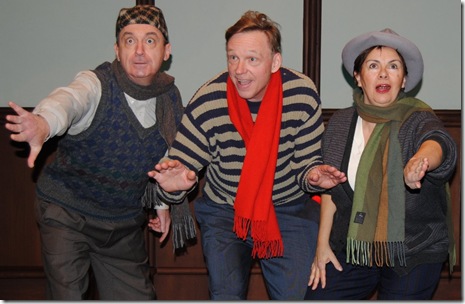GCTC’s Angel Square brings the good and the bad of post-war Ottawa to audiences
Photo: Barb Gray
Solve the crime and win the girl’s heart, all in time for Christmas. Superficially, Angel Square presents a sweet holiday yarn, but just below the surface we get a glimpse at race politics through the eyes of children, and a hopeful depiction of Ottawa’s working class heritage. Brian Doyle’s classic novel by the same name is newly adapted and directed by Janet Irwin. The production recounts twelve-year-old Tommy’s memory of Lowertown, Ottawa (Ontario, Canada, Planet Earth, The Universe) in 1945. It is the first Christmas after World War II and the impact of the war—from war rations to a sense of post-war relief—peppers the script, while anti-Semitism rears its ugly head.
Tommy (played by Bruce Spinney) is gutted that his best Jewish friend, Sammy, has left town. Sammy’s father has been badly beaten up and sent to a hospital in Kingston. Inspired by his superhero idol, The Shadow, Tommy is determined to find the ‘bad guy’. Stylistically, this production rides the line between being a memory play and youth theatre. Janet Irwin’s adaptation maintains Tommy’s role as the narrator of the story, while thrusting him inside the action of the play as he recalls the events leading up to Christmas.
Tommy’s best friends represent three distinct working-class communities – Irish-, French-, and Jewish-Canadians. Here, they work together to solve a crime that sheds light on the conflicted, post-war mindset in Ottawa. It’s just left of center of your average Christmas story, and resonates with current race-politics. These children have created an allegiance despite their separate heritages. It’s an aspirational type of characterisation. Angel Square represents a sort of meeting place for these three communities; the children must walk through it many times a day to get to and from school. While scuffles and trash-talking run rampant in the square, Irwin approaches these interactions with a clown-like playfulness. The cast, working as an ensemble, depict carefully choreographed fights à la Three Stooges. The kids aren’t true enemies divided along three imagined borders (though some of their parents might think so), only insofar as their playful skirmishes in Angel Square.
The set (Jock Munro) features a scenery flat of a cathedral-style tube radio, which is central to so many post-war era homes. It broadcasts news from abroad to the home-front. For Tommy and his friends it’s where their beloved radio-drama, The Shadow, takes place. The Shadow’s many heroic rescues mirror Tommy’s own heroic effort. The Shadow’s story is told through pre-recorded audio sequences paired with dramatic shadow-play cast through the back of the radio’s speakers. These pre-recorded sequences cause some disruption to the pace of the play; the live text and the pre-recorded text don’t run seamlessly. And though the overall impact is still achieved, the technical elements lack a certain fluidity. This is especially true in a scene where three children (live) are asking various neighbours to donate old comic books.
The casting of adults in the role of children endows the production with a symbolic nod to the fact that, through Tommy’s eyes, he and his friends seem very adult. Practically speaking, it means that the cast can work as an ensemble as they take on the various roles – child or adult alike – in the production. Kristina Watt, Mary Ellis and Robert Marinier transform into Tommy’s classmates. They shift through the many characters at times with such ease—it’s simply joyous. This ensemble work is especially effective in scenes that portray the handful of students at once, which the actors take on in exaggerated forms (through the prism of Tommy’s memory they become charicature-like). The smartest girl (Ellis), the dirtiest girl (Watt), and the teacher (Marinier) are just a few of the characters in Tommy’s class, each with their own physicality, voice, and intention. The end result is a really fun sequence, which repeats itself (to the audience’s delight) throughout the play.
The casting fails to achieve the same sort of effectiveness with narrator Tommy (Spinney) who is, by contrast, more realistic. Within each scene he is both inside the action of the play and outside that action, looking in. On one hand, this device allows the audience to accept the exaggerated characterization of his classmates. On the other hand, Spinney simply doesn’t come across as a child. The audience is left wondering if he’s an adult remembering his childhood, or if he is simply a child remembering his childhood, thinking himself very adult?
The production paints a dichotomous portrait of good and evil, of community and racism. The spirit of this production lives in its little touches – the nod to Tommy’s mentally delayed sister in the window (a fixture in Doyle’s writing), the lunar eclipse that pulls the community together, or a small child’s relationship with Santa. Audiences will inevitably find moments that will leave a smile on your face. Angel Square offers its audience some fun, just in time for the holidays. Who can balk at that.
